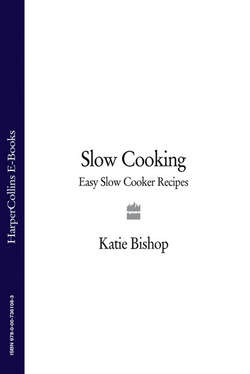Читать книгу Slow Cooking: Easy Slow Cooker Recipes - Katie Bishop - Страница 10
Choosing suitable ingredients
ОглавлениеWe have already discussed the increased use of slow-cooked, old-fashioned cuts of meat (see page 8). Some cuts (usually forequarter cuts from the front of the animal, or those parts of the animal that have had to work hard, such as legs and necks) are higher in fat and are naturally tougher through more rigorous or regular use. Slow moist cooking enables the protein in these muscles to break down, and produce gelatine, which makes the meat more tender and succulent. A fillet or breast with significantly less fat content may naturally be more tender, as it has done very little while the animal was alive, but will dry out more quickly during slow cooking and have less flavour and an unappealing, dry texture. If using higher fat meat concerns you, then rest assured that in the writing of this book, slow cooking has in the main proved to be a lower fat option to conventional cooking, as searing and frying of ingredients have often been unnecessary. Most meats look and taste better if ‘sealed’ or browned prior to cooking. However, the notion that meat must be browned to ‘seal’ in the meat juices during cooking and keep it moist is a myth. At 60°C (140°F) meat fibres begin to shrink and release their juice, whether ‘sealed’ or not. So, unless it is absolutely necessary for taste or appearance, the meat in this book is used directly to save time.
Fruit and vegetables vary too, some being rather more resilient to long slow cooking than others, despite the more delicate temperatures of the slow cooker. As you would expect, root vegetables will take longer cooking than soft, delicate vegetables like cauliflower and broccoli, although you may be pleasantly surprised by vegetables cooked with their skins on, such as aubergines and courgettes, which one may otherwise expect to disintegrate with lengthy cooking. Unless otherwise stated, place vegetables in the slow cooker dish first then top with the meat, if using, as this will ensure that the vegetables cook evenly and absorb all the tasty meaty juices. Fruit follows a similarly logical path, soft fruit breaking down significantly faster than stone fruit or apples and pears, for example, and fruit in skins holding up remarkably well.
Cut potatoes will turn black (oxidise) when in contact with the air, as will cut apples, pears and bananas. These must either be completely immersed in liquid during cooking or coated in lemon juice to prevent this ‘oxidisation’ from happening.
Dairy and sugar do not like very lengthy slow cooking (upwards of 6 hours) as they become denatured, especially when they are in concentrated form in cakes and desserts. Both seem to caramelise unpleasantly and start to break down. However, a few hours are fine, and if well diluted, in water, for example, there are few issues. If in doubt, stir dairy products in at the end of cooking to finish a dish, rather than cook with them for the duration.
Pasta can be cooked in the slow cooker but will become unpleasantly soft if cooked for too long. Try adding pasta to slow-cooked sauces about 30 minutes before the end of cooking. Lasagne and cannelloni are, however, more successful in the slow cooker (see Red Pepper, Basil and Ricotta Cannelloni on page 56).
Rice will absorb lots of excess moisture produced during slow cooking and therefore lots of flavour too. Add about 30–50 minutes before the end of cooking and stir a couple of times to ensure that it cooks evenly.
Dried beans still need to be soaked overnight before being cooked in the slow cooker. Dried red kidney beans must also be boiled for at least 10 minutes before draining and cooking to remove their dangerous toxins. Lentils, split peas and drained, tinned beans can be used directly.
Frozen ingredients must be defrosted before use in the slow cooker, otherwise they are unlikely to reach a safe cooking temperature, making them food poisoning time bombs!
The cooking liquid is an important part of success in slow cooking. As water is not lost in slow cooking in the way it is during extended stove-top simmering, the amount of water used to cook foods is normally reduced by about a quarter. Evaporation is reduced in the slow cooker as all the steam is retained in the pot; however, there is still some evaporation as the moisture/steam hits the hot sides of the cooking dish – this again will vary from one machine to another so keep an eye out when you are getting to know your cooker. Use water, stocks, wine, beer, cider, fruit juice or similar to cook in and add flavour. Bear in mind that when cooking with wine or vinegar the lack of evaporation means that the acidity and alcohol doesn’t cook off in the same way as stove-top cooking, so the flavour usually remains very pungent and undeveloped.
While cooking in liquid is particularly useful in slow cooking, so too is the ability to use the slow cooker as a water bath (also called a bain-marie). Gone are the hours of checking and worrying about steamers and pans boiling dry – this simply doesn’t happen in the slow cooker. A water bath is particularly useful when baking, creating a fantastically light sponge or fluffy custard. It’s good too in terms of cooking for long periods of time (clearly a moot point when discussing slow cooking, but in this instance a long period of time is 8–9 hours or perhaps overnight). It seems to provide a very gentle cook so that whether cooking overnight or cooking something that’s very delicate like a custard, the water bath produces a great result.
